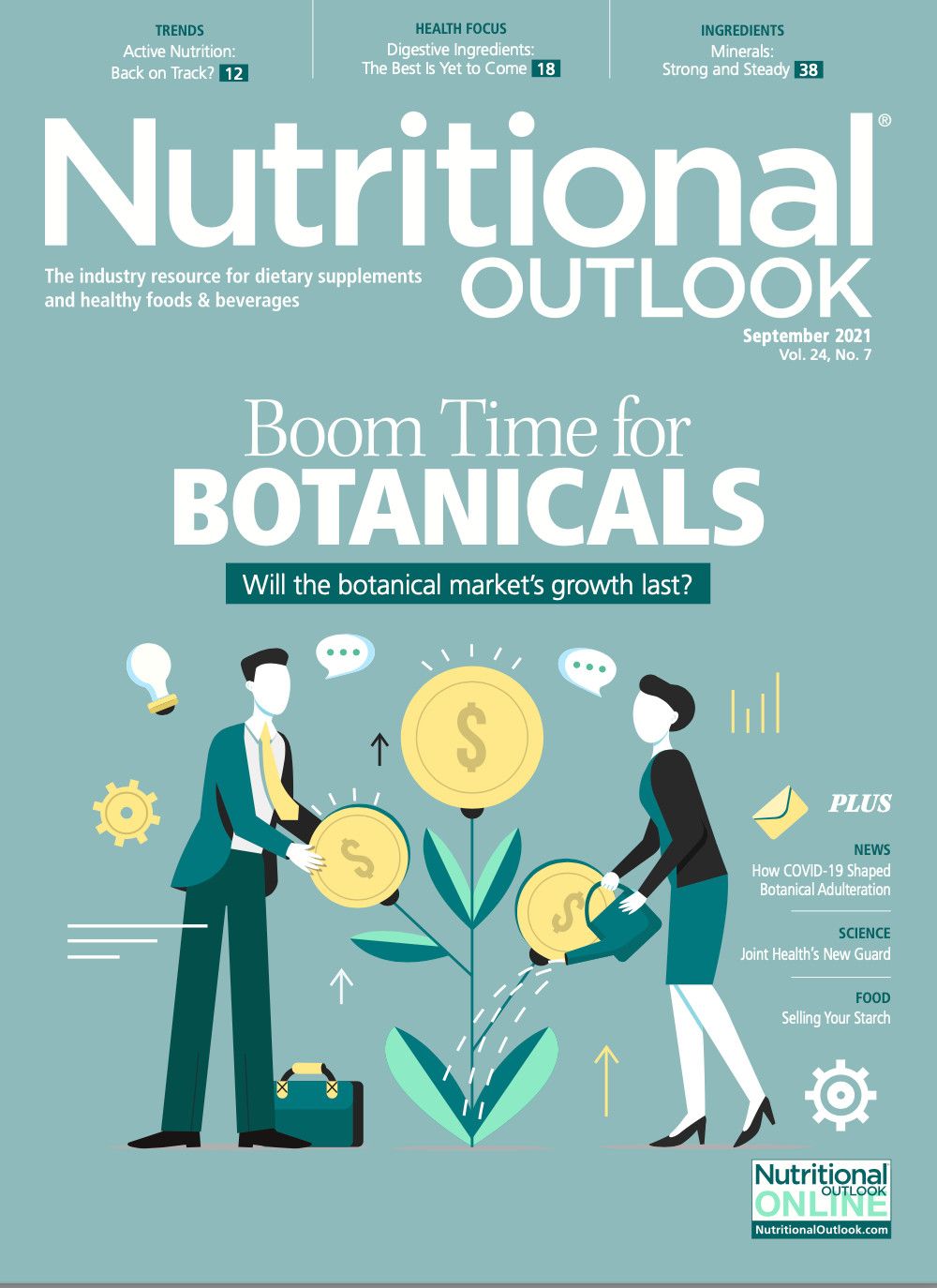Mineral Glow-Up: The growing popularity of minerals, COVID and beyond
In no small part thanks to COVID-19, minerals have enjoyed a real renewal, attracting attention for everything from their contribution to immune and sleep support to their ability to keep our bodies in solid working order.
Photo © Sashkin - Stock.adobe.com

So much of what spells success in the dietary supplement industry is what’s “new”: new ingredients, new benefits, new research, new delivery platforms. So, in such a dynamic space, how can minerals—literally as old as earth itself—ever hope to compete?
By doing what they’ve always done—that is, by being at least as innovative, exciting, and downright essential as any of the snazzy nutritional ingredients just now hitting the scene.
In fact, and in no small part thanks to COVID-19, minerals have enjoyed a real renewal, attracting attention for everything from their contribution to immune and sleep support to their ability to keep our bodies in solid working order when so much else seemed to be running off the rails.
Now that life is treading carefully back into normal territory, new developments—there’s that “new” word again—in minerals promise to keep these nutrients just as fresh, and just as front-and-center, as they deserve to be.
On the Radar
Make no mistake, “Minerals have broad appeal,” declares Marlena Hidlay, global strategic marketing manager, Albion Minerals at Balchem (Layton, UT). “The 2021 International Food Information Council Consumer Survey even found that 65% of consumers consider the presence of minerals in their food and beverage choices at least sometimes,” she adds.
The coronavirus pandemic only broadened that appeal as it sent consumers to supplement aisles in an effort to shore up their inner defenses and overall health. And going forward, Andrea Wong, PhD, senior vice president, scientific and regulatory affairs, Council for Responsible Nutrition (CRN; Washington, DC), is confident that “minerals will likely continue growing in popularity.”
Data from CRN’s COVID-19 Consumer Survey found that among the 91% of supplement users who reported increasing their supplementation routine in some way, 17% increased their zinc intake specifically, 16% upped calcium supplementation, 15% sought out more iron, and 14% took more magnesium—boosts in use that landed all four minerals among the top-10 vitamins and minerals that supplement users chose in 2020, Wong says.
Immunity and Beyond
As for why they turned to these minerals and more, one obvious reason was the public’s concerted pitch for better immunity.
“When it comes to immune health,” says Sevanti Mehta, president, Unibar Corp. (Houston, TX), “Nutrition Business Journal predicted 52% growth for 2020, and the industry continues to experience steady growth into 2021, as well.”
One consequence, he says, has been an upswell in demand for zinc—“an essential mineral that’s long been recognized as an immune booster by helping to regulate the inflammatory response and improve antioxidant capacity.”
Lalit Sharma, innovation manager, food/nutraceuticals, Omya International AG (Oftringen, Switzerland), adds that selenium and other trace minerals “are also performing well, particularly with immune-support products now booming year-round.”
But interest in minerals doesn’t orbit entirely around immune concerns. “Consumers are taking a more preventive approach overall these days,” Sharma continues, and supplementation’s role in that approach benefits all minerals.
For example, calcium—already valued for its bone benefits—“continues to see increased demand,” Sharma says. “And with healthy aging a strong driver, an ever-aging population makes it likely that bone-health supplements will continue to dominate, especially for women.”
Sound Body and Mind
Returning to zinc, Mehta points out that by helping to modulate the neuronal signaling involved in learning and memory, the mineral’s built a track record for cognitive support—“an area that’s seen a surge of interest over the past few years,” he adds.
Another mineral claiming cognitive ties is magnesium, and Patrick Stano, senior account executive and brand manager, Stauber Performance Ingredients (Fullerton, CA), points to a recent study1 involving middle-aged rats that indicated how a multi-mineral blend including Stauber’s Aquamin MG magnesium might reverse age-related cognitive impairments.
Behavioral assessments showed that four weeks of supplementation with the minerals “significantly reduced age-associated deterioration in the middle-aged rat subjects’ ability to perform a pattern-separation task,” Stano explains. “This is of interest, as an improvement in this type of cognition requires a unique type of brain plasticity, or flexibility, called neurogenesis.”
Another cognitive benefit attributable to magnesium is healthy sleep. “Stress is known to impact sleep,” Hidlay notes, and given the “huge increase in stress consumers experienced during the pandemic,” she continues, it’s no surprise that magnesium landed a spot in nearly 44% of the 1,609 new products or reformulations claiming a sleep benefit launched since January of 2019, according to market researcher Innova Market Insights.
“While many consumers take supplements with melatonin for sleep, others prefer melatonin-free solutions,” Hidlay says. “And here, magnesium bisglycinate chelate really shines. Not only does magnesium promote relaxation; supplementation with glycine has been shown to significantly improve subjective sleep quality.”2
Minerals and Probiotics
A glance in the rearview mirror offers an impressive view of the year that was for minerals. But by no means are their best days behind them.
Sharma sees “immense untapped potential in bringing minerals together with probiotics, peptides, and other bioactive compounds.” Case in point: A recently published study3 demonstrated significant reductions in body-mass index z (BMIZ) scores—measures of a child’s relative weight adjusted for age and sex—among female adolescents who supplemented with calcium plus Lactobacillus casei. These body-mass reductions “may reduce the risk for obesity later in life,” Sharma notes, adding that the study “shows the positive effects of administering calcium with probiotics.”
Internal Omya research also found that functionalized calcium carbonate (FCC)—a high-purity, natural form of calcium that’s undergone surface recrystallization via a patented technology—outperforms maltodextrin as a stabilization matrix for Lactobacillus plantarum strain WCFS1 in multiple model systems.
“Cultures were mixed with either maltodextrin or our mineral solution and spray-dried to evaluate survival rates,” Sharma explains. “Then, to assess the stabilizers’ efficacy during digestion and accelerated shelf life, the spray-dried powders were blended with skim-milk powder or pressed into tablets using lactose as an excipient.” Not only did mineral stabilization display “significantly better stabilizing effects compared to maltodextrin,” he said; it ultimately delivered up to 1000 times more probiotic in both model systems. Further research confirmed that the new solution is “officially the first inorganic agent for enhancing probiotic stability and performance,” Sharma says.
Mineral-Boosted Botanicals
For his part, Mehta predicts “great opportunity in active nutrition for mineral supplementation,” adding that “we’ve been teasing the launch of our Univita beetroot ingredient, which contains a higher content of natural nitrates to improve cardiovascular function and reduce fatigue rates.”
The higher nitrate content is possible thanks to a patented biofortification process that Mehta claims helps botanicals absorb more minerals and nutrients from the soil. This improves the ingredients’ inherent nutrient and mineral profile and—as an added benefit—“helps convert the absorbed minerals into their chelated forms, improving mineral bioavailability,” he says.
The process also renders synthetic fortification unnecessary. “Many botanicals with higher mineral contents are fortified artificially,” Mehta explains. “Avoiding the use of synthetics helps to provide a clean, plant-based label while also protecting consumers from potentially adverse reactions and side effects. Synthetics may be convenient, but sourcing minerals naturally often delivers better absorption so that the body can better use them to improve health.”
The Univita line now offers three Ayurvedic ingredients—guava leaves, holy basil, and amla Indian gooseberry—that Mehta says “are strong supports for a variety of health factors and have higher levels of zinc and magnesium to satisfy current lifestyle needs.”
Finite Resources
When Eugenia Erlij, vice president, marketing, Innophos Holdings Inc. (Cranbury, NJ), looks at the prospects for minerals, she sees a future where things start getting personal.
“As technology advances and companies move further toward personalized nutrition,” she says, “we may see more advanced condition-specific offerings that feature controlled-release performance for maximum efficacy.” Regardless of the delivery format, however, she cautions developers to mind the challenges. “Material characteristics like solubility, pH, density, flavor profile, and particle size all need consideration for optimum performance,” she advises.
She also echoes Mehta’s comments about keeping mineral formulations clean. “According to Innova Market Insights, dietary supplement launches with clean-label claims rose [by] more than [a] 20% CAGR between 2017 and 2020,” she notes. “We already see growing demand for amino acid–based chelated minerals, which combine a mineral and organic ligand and are better aligned with clean-label trends.”
And claims around “clean” sustainable formulations will likely persist, even for minerals. After all, as a natural resource, minerals are inherently finite in supply and deserve to be part of the sustainability discussion. They may be as old as the planet, but they’ll only be around if it is.
References
- Crowley EK et al. “A reduction in behavioral pattern separation is attenuated by dietary supplementation with a magnesium-rich marine mineral blend in middle-aged rats.” Journal of Medicinal Food. Published online June 29, 2021.
- Yamadera W et al. “Glycine ingestion improves subjective sleep quality in human volunteers, correlating with polysomnographic changes.” Sleep and Biological Rhythms, vol. 5, no. 2 (April 2007): 126-131
- Setiawan EA et al. “Tenth year reenrollment randomized trial investigating the effects of childhood probiotics and calcium supplementation on height and weight at adolescence.” Scientific Reports, vol. 11, no. 1 (June 4, 2021): 11860

Prinova acquires Aplinova to further increase its footprint in Latin America
April 7th 2025Prinova has recently announced the acquisition of Brazilian ingredients distributor Aplinova, which is a provider of specialty ingredients for a range of market segments that include food, beverage, supplements, and personal care.






















